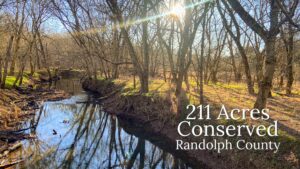
by Ruth Ann Grissom
February 2, 2017
 In a speech commemorating the bicentennial of Andre Michaux’s summit of Grandfather Mountain in 1794, Charles Kuralt claimed the famed French botanist “knew that within his sight…exists a greater variety of plant life than can be found in all of Europe, from the arctic capes of Scandinavia to the shores of southern Greece.” Conservationist Tom Earnhardt referenced that observation during his talk at the Charlotte Garden Club (www.charlottegardenclub.org) meeting last month.
In a speech commemorating the bicentennial of Andre Michaux’s summit of Grandfather Mountain in 1794, Charles Kuralt claimed the famed French botanist “knew that within his sight…exists a greater variety of plant life than can be found in all of Europe, from the arctic capes of Scandinavia to the shores of southern Greece.” Conservationist Tom Earnhardt referenced that observation during his talk at the Charlotte Garden Club (www.charlottegardenclub.org) meeting last month.
Earnhardt, a Thomasville native and host of the popular public television program Exploring North Carolina, frequented the wild places of the Uwharries in his youth and discovered his passion for nature at his family’s property on Bear Wallow Mountain near the Eastern Continental Divide.
He describes North Carolina as “the toast of the temperate universe.” Citing boreal forests in the mountains and subtropical palms on the coast, he claims the state is the “Crossroads of the Natural World.” (Also the title of his 2013 book from UNC Press.) North Carolina sits at a particularly rich intersection – where the Gulf Stream collides with colder currents near Cape Hatteras, where the tallest peaks in the eastern U.S. tower over the foothills, where Ice Age glaciers scoured the land to our north but left our prehistoric biodiversity intact.
Earnhardt seems to possess an encyclopedic knowledge of this diversity, rattling off facts and figures without consulting notes. North Carolina, he says, is home to 75 species of orchids, 38 oaks, nine pines and 8000 mushrooms. We have 38 “good neighbor” snakes, 23 lizards, 45 crayfish, 21 freshwater turtles, 265 freshwater fish and 450 birds. We commonly see only a handful of the 185 butterfly species and a tiny fraction of the 3000 moths, many of which rely upon a single plant species for their survival.
This abundance brings to mind a biblical passage: To whom much has been given, much is required. We are challenged to preserve this gift of biodiversity, especially when the environment in our rapidly-growing state is also at a crossroads. Eminent biologist E. O. Wilson estimates we would need to preserve half our land mass in order to protect these species. As we struggle to move the needle to 10% in North Carolina, we have to face the fact that public land alone will not be sufficient. We need to get creative.
Earnhardt suggests planting more natives along our streets and roads. Replace the zinnias, cosmos, Flanders poppies and the “not our lilies” along the interstates. This hostile environment would be ideal for hardy species such as native grasses, milkweed, ironweed, goldenrod, coneflower and sunflower. This is done to stunning effect in Texas where Hill Country roadsides are blanketed with bluebonnets in spring. As Earnhardt noted, Lady Bird Johnson, wildflower advocate and muse of the Highway Beautification Law, thought Texas ought to look like Texas, and North Carolina ought to look like North Carolina.
Just as our cities and towns are connected by roads, we need to build a system of connectivity between large tracts of public land. Earnhardt also urges the preservation and restoration of wooded buffers along our creeks and rivers. These corridors allow the migration of plants and animals. In addition, they improve water quality and create linear parks suitable for greenways.
What does all this have to do with gardeners? As I’ve stressed in previous articles, we are stewards of the natural world. Crepe myrtles, azaleas and camellias are now synonymous with the South, but they aren’t native to the region, and they don’t nurture native insects and birds. We don’t need to banish them from our yards, but we do need to make space for natives in the landscapes we tend. Gardeners have the power to provide milkweed for the monarchs, pawpaws for the zebra swallowtail, and cardinal flower or coral honeysuckle for the ruby-throated hummingbird.
The late Bill Friday, always wise and insightful, recognized this dilemma at the conference center that honors him in Chapel Hill. He and his wife had named the meeting rooms for local wildflowers and trees – trillium, redbud, dogwood, magnolia – but one day he realized the landscaping was dominated by exotic species. As he was apt to do immediately after a new episode of Exploring North Carolina had aired, he picked up the phone and called Tom Earnhardt. Friday said he wanted the outside of the building to look like the inside. He wanted the landscaping to reflect the natural beauty of the state he held so dear.